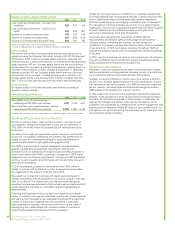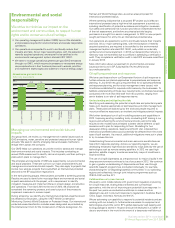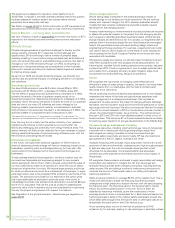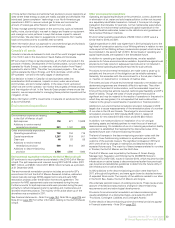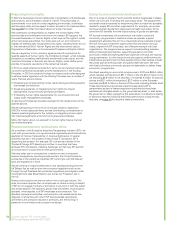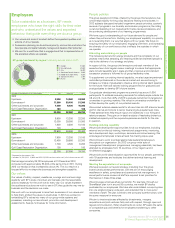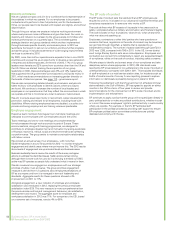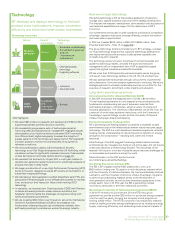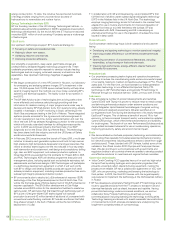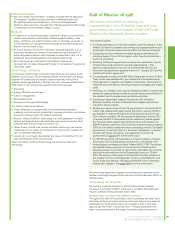BP 2012 Annual Report Download - page 62
Download and view the complete annual report
Please find page 62 of the 2012 BP annual report below. You can navigate through the pages in the report by either clicking on the pages listed below, or by using the keyword search tool below to find specific information within the annual report.
Business review: BP in more depth
BP Annual Report and Form 20-F 2012
60
response and describes the rigorous process for determining that
operational removal activity is complete.
By the end of 2012, the FOSC had deemed removal actions complete on
4,029 miles (6,484kms) of shoreline out of the 4,376 miles (7,043kms)
that were in the area of response. Approximately 108 miles were pending
final monitoring or inspection and a determination that removal actions are
complete. The remaining 239 miles are in the monitoring and maintenance
phase, which will continue until the FOSC determines that operational
removal activity is complete.
According to a study by the Operational Science Advisory Team (OSAT),
composed of scientists representing federal agencies and BP, the residual
oil that remains is heavily weathered, contains only a small fraction of the
compounds of concern and is below the EPA’s benchmarks for the
protection of human health.
The US Coast Guard has indicated that if oil is later discovered in a
shoreline segment where removal actions have been deemed complete,
they will follow long-standing response protocols established under the
law and contact whoever it believes is the responsible party or parties.
Hurricane Isaac
In late August 2012, Hurricane Isaac made landfall on the Gulf Coast,
uncovering residual oil in some areas in Louisiana. The remaining residual
oil had been buried when tropical storms in 2010 and 2011 deposited
several feet of sand along some of the Gulf Coast shoreline. After the
material was buried, in many instances, net environmental benefit analysis
had indicated that deep cleaning at these sites could do more harm than
good. But once Isaac removed this sand overburden in some places,
clean-up crews have been able to clean the residual material without the
same degree of potential environmental impact.
Other shorelines in the area of response were less affected by Hurricane
Isaac. A few areas saw a short-term increase in the number of tar balls in
the initial aftermath, but conditions returned to pre-Isaac levels after a few
days once clean-up operations were resumed in these locations.
Response efforts guided by science
Scientific studies conducted at the direction of the FOSC continued to
guide response actions and help define what is known scientifically about
the fate of the oil and the potential impacts to human health, aquatic life,
wildlife and the environment. This included OSAT studies and net
environmental benefit analyses conducted in 2010 and 2011.
At the request of BP, the FOSC formed another OSAT in 2012 to
investigate discrete areas of buried oil accumulations (tar mats) near the
shoreline. The team was directed to integrate a number of data sets to
evaluate the potential for buried oil in discrete locations across the area of
response and determine if additional mitigating actions may be taken to
excavate the residual material with minimal environmental impact.
Economic recovery
BP continued to support economic recovery efforts in local communities
through a variety of actions and programmes in 2012. By 31 December
2012, BP had spent nearly $10 billion on economic recovery, including
claims, advances, settlements and other payments, such as state tourism
grants and funding for state-led seafood testing and marketing. In
addition, $1.8 billion has been paid to the seafood compensation fund,
which has not yet been paid to final claimants.
Plaintiffs’ Steering Committee settlements
In April 2012, BP reached settlements with the Plaintiffs’ Steering
Committee (PSC) to resolve the substantial majority of legitimate economic
loss and medical claims stemming from the accident. In May 2012, the court
preliminarily approved the settlements. The PSC acts on behalf of individual
and business plaintiffs in the multi-district litigation proceedings pending in
New Orleans.
Typically in class action settlements, claims are not paid until after the
court has granted final approval to the settlement and all appeals have
been exhausted. Here, BP took the unusual step of agreeing to process
and pay claims under the economic and property damages agreement
prior to any such court approval. Accordingly, a court-supervised
transitional claims programme took over the processing and payment of
economic loss claims from the Gulf Coast Claims Facility on 8 March 2012.
On 4 June 2012, the transitional process was closed, and the Deepwater
Horizon Court Supervised Settlement Program (DHCSSP) began
processing and paying claims from settlement class members under the
economic and property damages agreement.
In November 2012, the court held a fairness hearing with respect to the
settlements and subsequently granted final approval of the economic and
property damages agreement on 21 December 2012 and of the medical
benefits class action settlement agreement on 11 January 2013.
Under the economic and property damages agreement, there are agreed
compensation protocols for the payment of class members’ economic
and property damages. In addition, many economic and property
damages settlement class members will also receive payments based on
negotiated risk transfer premiums, which are multipliers designed to
compensate claimants for potential future losses relating to the accident,
along with other potential damages.
Under the medical benefits class action settlement agreement, payments
will be made based on a matrix for certain specified physical conditions.
The agreement also provides for a 21-year Periodic Medical Consultation
Program for qualifying class members. Class members claiming later-
manifested physical conditions may pursue their claims in the future
through a mediation or litigation process, but waive the right to seek
punitive damages.
In addition, under the medical benefits class action settlement agreement,
BP has agreed to provide $105 million to the Gulf Region Health Outreach
Program to improve the availability, scope and quality of healthcare in Gulf
communities. The focus will be on strengthening local capacity to deliver
primary care, behavioural and mental health services, and environmental
medicine. This healthcare outreach programme is intended to benefit both
class members and others in those communities. BP provided approximately
$20 million in 2012 to launch the assessment and evaluation phase of the
health outreach programme across the four Gulf States.
Business economic loss claims received by the DHCSSP to date are being
paid at a higher average amount than previously assumed by BP in
formulating the original estimate of the cost of the PSC settlement,
resulting from an interpretation of the settlement agreement by the claims
administrator that BP believes was incorrect. As more fully described in
Legal proceedings on pages 162-169, this matter has been considered by
the court and on 5 March 2013, the court affirmed the claims
administrator’s interpretation of the settlement agreement and rejected
BP’s position as it relates to business economic loss claims. BP strongly
disagrees with the ruling of 5 March 2013 and the current implementation
of the agreement by the claims administrator. BP intends to pursue all
available legal options, including rights of appeal, to challenge this ruling.
Given the inherent uncertainty that exists as BP pursues all available legal
options to challenge the recent ruling, and the higher number of claims
received and higher average claims payments than previously assumed by
BP, which may or may not continue, management has concluded that no
reliable estimate can be made of the cost of any business economic loss
claims not yet received or processed by the DHCSSP. As a consequence,
an amount of $0.8 billion previously provided for such claims has been
derecognized. A provision will be re-established when a reliable estimate
can be made of the liability. For further information see Financial
statements – Note 36 on page 235, Note 43 on page 253 and Risk factors
on pages 38-44.
BP’s current estimate of the total cost of those elements of the PSC
settlement that can be estimated reliably, which excludes any future
business economic loss claims not yet received or processed by the
DHCSSP, is $7.7 billion. If BP is successful in its challenge to the court’s
ruling, the total estimated cost of the settlement agreement will,
nevertheless, be significantly higher than the current estimate of
$7.7 billion, because business economic loss claims not yet received or
processed are not reflected in the current estimate and the average
payments per claim determined so far are higher than anticipated. If BP is
not successful in its challenge to the court’s ruling, a further significant
increase to the total estimated cost of the settlement will be required.
However, there can be no certainty as to how the dispute will ultimately
be resolved or determined. To the extent that there are insufficient funds
available in the Trust fund, payments under the PSC settlement will be
made by BP directly, and charged to the income statement.
Significant uncertainties exist in relation to the amount of claims that are
to be paid and will become payable through the claims process. There is
significant uncertainty in relation to the amounts that ultimately will be


